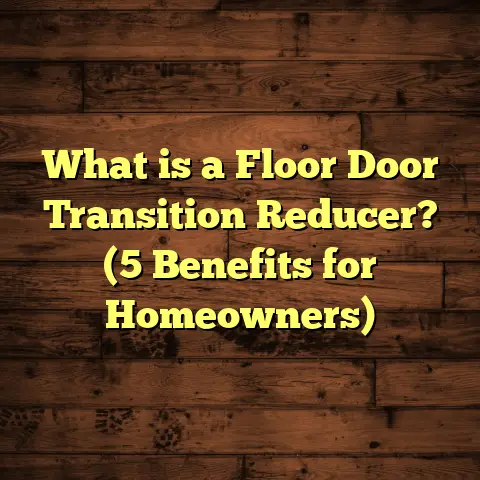What is Laminate Flooring Installation Cost? (5 Factors to Consider)
I want to share with you a little secret about laminate flooring — over the years, it has become my go-to recommendation for anyone wanting a stylish, durable floor without spending a fortune. I’ve installed laminate floors in all kinds of homes, from tiny apartments to sprawling family houses, and I’m always impressed by how versatile and cost-effective this option can be. But one thing I’ve noticed is people often get confused or overwhelmed when they try to figure out what their laminate flooring installation will really cost.
Maybe you’ve seen prices that seem too good to be true, or maybe contractors have given you wildly different numbers. That’s exactly why I decided to write this detailed guide. I want you to feel confident and informed when deciding on laminate flooring for your home — and to understand exactly what affects the price.
So, what is laminate flooring installation cost? More importantly, why does that cost vary so much? Let me walk you through everything, including some stories and numbers from my own experience, so you get a clear picture.
What Exactly Is Laminate Flooring Installation Cost?
When I say “laminate flooring installation cost,” I mean the total amount you’ll spend from start to finish to have laminate floors installed in your home. This includes:
- The laminate planks themselves (the materials)
- Labor charges for the installation
- Any preparation work needed for the existing subfloor
- Additional materials like underlayment, trims, or transition strips
- Removal of old flooring if necessary
- Special requests like waterproofing or radiant heating systems
Laminate flooring is a synthetic product designed to mimic natural wood or stone. It’s composed of multiple layers fused under high pressure: a wear layer on top, a photographic design layer beneath that, a core usually made from high-density fiberboard (HDF), and a backing layer for moisture resistance. Because it’s manufactured this way, laminate is generally easier and faster to install than hardwood or tile floors, which can make it more affordable overall.
However, the final price depends on several key factors — material quality, room size and shape, labor rates where you live, prep work needed, and any extras you want added in.
I’ll take you through each of these five factors step-by-step. Along the way, I’ll share real data points from projects I’ve worked on and stories that highlight why costs vary so much.
1. Material Quality and Type
This is the first place most people start when budgeting for laminate flooring. And it makes sense — the type of laminate you pick affects not just how your floor looks but how much it costs.
Different Grades and Their Price Ranges
Laminate flooring comes in various grades based on thickness, durability, texture realism, and brand reputation.
- Entry-level laminates: These usually cost between $0.70 and $1.50 per square foot. They’re thinner (around 6mm) with a thinner wear layer and less realistic surface textures. While they’re budget-friendly, they might show wear sooner in high-traffic areas.
- Mid-range laminates: The sweet spot for most homeowners. These cost approximately $1.50 to $3 per square foot. At this level, thickness typically ranges from 8mm to 12mm with a tougher wear layer and textured finishes that convincingly mimic wood grain or stone.
- Premium laminates: These are top-of-the-line products costing $3 to $5+ per square foot. They often feature water-resistant or waterproof cores, ultra-realistic embossing techniques that replicate wood knots or stone veins, and thicker wear layers (20+ mil). Brands like Pergo and Mohawk dominate this category.
From my experience installing floors across different client budgets, most people choose mid-range laminates because they strike a good balance between durability and appearance.
Underlayment Costs
Laminate floors almost always require an underlayment — a thin layer placed between the subfloor and the laminate planks to cushion footsteps, reduce noise, and provide moisture protection.
Common underlayment options include foam, felt, cork, or rubberized products.
- Standard foam underlayment costs around $0.30 to $0.50 per square foot.
- Premium soundproofing or moisture barrier underlayments can run $0.50 to $1 per square foot.
If you skip underlayment to save money (which I don’t recommend), your floor might feel harder underfoot and be noisier.
Other Materials
Don’t forget about transition strips (where laminate meets other flooring types), baseboards or quarter round trim to cover expansion gaps along walls, and adhesives if your installation needs glue-down methods.
These extras usually add $0.50 to $2 per square foot depending on room size and detail work.
2. Room Size and Layout Complexity
We all know bigger rooms require more material — but there’s more to it than just square footage.
How Room Shape Affects Installation Time and Cost
Straightforward rectangular or square rooms are the easiest because installers can quickly measure, cut straight lines, and lay planks efficiently.
But rooms with:
- Lots of corners
- Odd angles
- Built-in shelves or cabinetry
- Doorways leading into multiple rooms
- Bay windows or alcoves
…take longer because every cut has to be precise. Each notch or angle means extra time measuring and cutting planks carefully.
I once installed laminate in a living room with an irregular shape — four separate doorways leading into connecting rooms plus a fireplace hearth jutting into the floor space. The complexity added about 25% more labor time compared to a simple rectangular space of the same size.
Impact on Material Waste
More complex layouts also tend to increase waste because of offcuts from irregular cuts.
While most installers factor in 5-10% extra material for waste on any job, complex shapes may push that toward 10-15%.
3. Installation Method and Labor Rates
The method used for installation plays a massive role in labor costs.
Installation Methods
There are two main ways laminate flooring gets installed:
- Floating floor installation: The most common method where planks snap together without being glued or nailed down to the subfloor. This method is fast, clean, and allows the floor to expand/contract naturally with temperature changes.
- Glue-down installation: Less common but required for some commercial settings or specific subfloors like concrete without an underlayment vapor barrier. This method is slower because each plank must be glued carefully.
Floating floors usually cost less in labor since installers can work quickly without waiting for glue to dry.
Labor Cost Differences by Location
Labor rates vary dramatically depending on where you live.
Here’s a quick snapshot from various U.S. metro areas based on recent data:
| City | Average Labor Cost (per sq.ft) |
|---|---|
| New York City | $4.00 – $6.00 |
| Los Angeles | $3.50 – $5.50 |
| Chicago | $2.50 – $4.00 |
| Dallas | $1.75 – $3.00 |
| Rural Midwest | $1.50 – $2.50 |
I work mainly in mid-sized cities where labor tends to fall between $2 and $3 per square foot for floating installations.
DIY Versus Professional Installation
Many homeowners consider installing laminate themselves since it’s designed as a floating floor with click-lock planks.
If you do it yourself (DIY), you save on labor but need to factor in:
- Time spent learning techniques
- Tools required (saws, spacers)
- Potential mistakes that cause wasted materials
I always tell clients: if your room is complex or large, professional installation usually pays off by saving time and avoiding costly errors.
4. Subfloor Preparation and Removal Costs
This is probably the biggest surprise for many people — what condition is your existing floor in?
Why Subfloor Condition Matters
Laminate flooring needs a flat, clean surface underneath for proper installation:
- Wood subfloors should be dry and smooth.
- Concrete should be level and free of cracks.
- Old adhesive residues should be removed if you’re replacing vinyl or tile.
If your subfloor isn’t ready, it needs prep work like:
- Leveling uneven spots with patch compound.
- Replacing rotten plywood sections.
- Cleaning up glue or staples.
I once had a client whose hardwood floors were warped from water damage — we had to replace half the plywood subfloor before installing laminate. That prep alone added over $1,000 to their project cost.
Removal of Old Flooring
If you have carpet, vinyl sheet goods, or old tile, those have to be removed first.
Removal costs vary depending on material type:
| Material Type | Removal Cost (per sq.ft) |
|---|---|
| Carpet + padding | $0.50 – $1.00 |
| Vinyl sheet | $1.00 – $2.00 |
| Tile | $2.00 – $4.00 |
Some old tiles contain asbestos or glue adhesives that require special handling — this can significantly increase removal costs due to safety regulations.
5. Additional Features and Special Requests
Sometimes clients want specific features that increase costs but improve usability or aesthetics.
Radiant Heating Systems Beneath Laminate
Radiant heating mats under laminate add warmth underfoot during cold months — a popular upgrade in northern climates.
Installation requires carefully laying electric mats on the subfloor before installing the laminate without damaging heating wires.
This adds:
- Material cost for the heating mats ($5 – $15 per sq.ft depending on system)
- Extra labor time ($3 – $7 per sq.ft)
If you’re thinking about this feature, plan for an additional $8 to $20 per square foot total above standard laminate costs.
Waterproof or Water-Resistant Laminates
Some laminates now boast waterproof cores that withstand spills and moisture better than traditional types.
These products often use specially treated fiberboard cores or plastic cores instead of wood-based ones.
Waterproof laminates cost more upfront — expect $3 to $5+ per square foot for good waterproof versions versus $1-$3 for standard laminates.
Custom Patterns and Borders
While most laminate floors are installed in straight lines parallel to walls, some clients want patterns like:
- Herringbone
- Diagonal layouts
- Checkerboard effects
- Borders with contrasting colors
These require more precise cutting and layout planning — increasing labor costs by 20% to 50%.
Real-Life Project Cost Examples
To give you some more tangible ideas, here are several projects I’ve worked on recently with detailed costs broken down:
Project A: Simple Living Room Replacement
- Room size: 300 sq.ft.
- Materials: Mid-range laminate ($2/sq.ft)
- Underlayment: Standard foam ($0.40/sq.ft)
- Labor: Floating floor installation ($2/sq.ft)
- Prep: None needed
- Old flooring: Removed carpet by client
Total Cost Estimate:
Materials + underlayment = (300)(2 + 0.4) = $720
Labor = (300)(2) = $600
Overall total = $1,320 (~$4.40/sq.ft)
Project B: Complex Kitchen + Dining Area
- Room size: 500 sq.ft.
- Materials: Premium waterproof laminate ($4/sq.ft)
- Underlayment: Premium moisture barrier ($0.75/sq.ft)
- Labor: Floating floor installation with complex cuts ($3/sq.ft)
- Prep: Concrete leveling ($1/sq.ft)
- Old flooring: Removed vinyl tile ($1/sq.ft)
Total Cost Estimate:
Materials + underlayment = (500)(4 + 0.75) = $2,375
Labor = (500)(3) = $1,500
Prep + removal = (500)(1 + 1) = $1,000
Overall total = $4,875 (~$9.75/sq.ft)
Project C: Basement With Radiant Heat Upgrade
- Room size: 400 sq.ft.
- Materials: Mid-range laminate ($2/sq.ft)
- Underlayment: Foam + moisture barrier ($0.60/sq.ft)
- Labor: Glue-down installation ($4/sq.ft)
- Prep: Uneven concrete leveling ($1/sq.ft)
- Radiant heat mats ($7/sq.ft)
Total Cost Estimate:
Materials + underlayment = (400)(2 + 0.6) = $1,040
Labor = (400)(4) = $1,600
Prep = (400)(1) = $400
Radiant heat = (400)(7) = $2,800
Overall total = $5,840 (~$14.60/sq.ft)
How To Budget Smartly For Your Laminate Flooring Project
From all these details and real-world examples — what should your approach be?
Step 1: Measure Your Space Accurately
Don’t guess your room size! Get out your tape measure or laser measurer and calculate length × width for each room separately.
If your room has odd shapes or nooks, break it into rectangles then add areas together.
Step 2: Inspect Your Existing Floor Condition
Check if your current floor is flat and dry with no major damage.
If unsure, consider having an installer come by for a quick assessment before buying materials.
Step 3: Decide On Material Grade Based On Usage
Think about how much traffic your floor will get:
- Low traffic bedrooms might be fine with entry-level laminates.
- Kitchens or family rooms benefit from premium water-resistant products.
Matching grade with usage helps prevent premature wear and costly repairs later.
Step 4: Factor In Labor Rates Where You Live
Call local installers for quotes or check online resources like HomeAdvisor or Angie’s List to see typical labor costs in your area.
Step 5: Account For Prep And Removal Costs Early
Don’t ignore potential expenses removing old floors or leveling subfloors — these can add hundreds or thousands if delayed until after purchase!
Waste Factor – Ordering Extra Material To Avoid Delays
In my projects, I always order at least 5% extra material over calculated floor area to cover cutting waste and accidental damage during installation.
For complex rooms or diagonal layouts, I bump this up to 10%.
This prevents delays caused by running out mid-job which can stall progress while waiting for more material deliveries.
My Personal Stories From The Field
I remember one client who bought bargain basement-grade laminate from a big box store without consulting me first — they thought all laminates were basically the same price-wise.
When I arrived to install their floors in a large dining room with lots of angles and doorways into adjacent rooms, I realized the material was very thin and brittle compared to what I usually use.
We had several planks snap during cutting because they were so flimsy — doubled waste rate plus increased labor time trying to fit fragile pieces perfectly around obstacles.
In total their project ended up costing more due to delays replacing material than if they had invested in mid-grade laminate upfront.
Another time I worked with a couple who wanted radiant heating beneath their basement laminate floors — something they hadn’t budgeted for initially but loved after we explained benefits during our consultation.
Because they planned ahead on subfloor prep and chose a premium waterproof laminate compatible with radiant heat systems, their project went smoothly — though it did cost nearly triple what basic floating laminate installation would have been.
Unique Insights From My Experience And Research
Laminate flooring has come a long way since its early days as cheap imitation wood floors prone to scratching and water damage.
Thanks to advances in manufacturing technology:
- Many laminates now feature embossed textures that mimic real wood grain almost perfectly.
- Some brands offer lifetime warranties against wear.
- Water-resistant cores allow use in kitchens or even bathrooms.
But these improvements come at higher prices — so balancing quality with budget is key.
Also interesting: In recent years I’ve seen a growing trend where homeowners combine laminate floors with area rugs instead of wall-to-wall carpeting for easier cleaning plus style versatility without sacrificing comfort.
A Quick Note About DIY vs Hiring Pros Again
I’m all for DIY if you have time and patience — installing laminate yourself can save a lot of money on labor costs which are sometimes half the total bill!
However:
- If your room isn’t perfectly flat,
- If you want complex layouts,
- Or if you have pets/kids who need durable waterproof floors,
Hiring professionals tends to result in longer-lasting floors that look better right from day one.
Summary Of Typical Costs Per Square Foot By Project Type
| Project Type | Total Cost Range Per sq.ft |
|---|---|
| Basic floating floor | $3.50 – $5 |
| Mid-range complexity | $5 – $7 |
| Premium waterproof/radiant heat | $7 – $15 |
Final Thoughts From Me To You
Laminate flooring is one of the best-kept secrets for affordable beautiful floors that last if installed correctly with the right materials.
Knowing exactly what affects installation costs helps you:
- Avoid sticker shock
- Plan your budget realistically
- Choose materials that suit your lifestyle
- Prevent costly mistakes during installation
If you ever want help estimating costs tailored specifically for your home’s location and floor size/material preferences — try tools like FloorTally which I use often as a quick reference.
Feel free to ask me questions anytime about specific details — whether about choosing materials or prep tips before installation — I’m here to help make your flooring project smooth and successful!
Let me know what else you’d like me to add!





